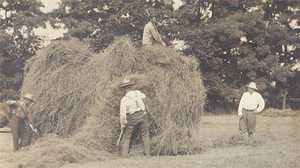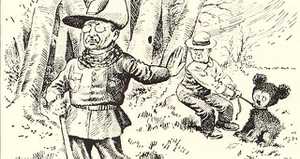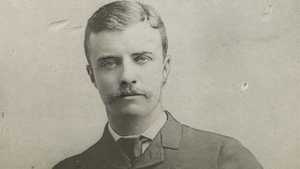Filmmaker David Grubin on TR
Producer David Grubin discusses TR and the process of making the film.

TR
In making a film about Theodore Roosevelt you can't help but be touched by his enthusiasms. Imagine a president who could speak many different languages, a president who had an intellectual curiosity that ranged so wide across science, across history. He was a best-selling author. He was a big game hunter, a cowboy. There are so many different facets to the life of Theodore Roosevelt that make him a fascinating figure to cover. And he was so exuberant.
He had an opinion on everything. You may disagree with his opinions, but they're fun, some of them, to just hear. Although startling. For instance, the idea that it was the patriotic duty of every healthy American wife to bear her husband at least four children. That's an incredible thing to say. He believed in simplified spelling. Well, maybe we all believe that it would be easier if we didn't have to remember "i before e and except after c," but he went and tried to do something about it and raised a ruckus, also, an uproar. It's not easy to change spelling and he didn't mind putting those kinds of issues before the American public.
In the end Roosevelt saw the presidency as a moral force for the country. We talk a lot today about moral values and the presidency. Well, Roosevelt said my issues are moral issues, the presidency is a bully pulpit. But for him the central moral issues for Americans were that Americans should know their vigor, should know their strength, that Americans should stand up and take their place on the world stage, that Americans should lead the strenuous life as people and be vigorous as a nation. There was a darker side to that, too, which makes him interesting because he believed America should take its rightful place on the world stage but it was also a form of imperialism. When he said speak softly and carry a big stick he meant that America should be a guiding spirit for the rest of the world. He didn't think that the rest of the world had their own sense of morality, their own sense of nationhood. He was ready to go into Panama or go into the sovereign nation of Columbia, and take Panama away from them.
How TR Changed the Presidency
You have to remember that before TR, the president wasn't expected to play such a dominant role in our national life. TR, by the very nature of his character, took that role, made the presidency an active force. He couldn't help himself. He was a man who believed in action and he believed that the government needed to play a role in our national life. He believed that it was up to the government to give everybody, as he said, a square deal.
We forget that the government was small then, that business really ruled the country. Roosevelt said it's important for the government to regulate business, it's important for the government to step in and balance the power of business. Well, we face the same problems today. What should be the relationship of government to the economy, government to business? Roosevelt was grappling with those problems right at the beginning of the century and it's now the end of the century and we still grapple with that problem. Roosevelt was also an interesting President and relevant to our times. Roosevelt is a President relevant to our times because he deals with issues relevant to our times. The relationship between the government and business, the relationship between government and the environment.
No president has acted as vigorously to protect the national resources as Roosevelt. Before Roosevelt presidents really weren't concerned with the, with our national resources. He was really the greatest conservationist president in our history and he faced down special interests to save over 230 million acres of wilderness for us and our descendants. Well, today we face similar problems. What should the government's role be in protecting our environment? For TR, there wasn't a question there. He went out and acted in the interest of the environment.
TR's was also fascinating to me because he was a man of, rich in contradictions. Here was a man who showed courage and fortitude charging up San Juan Hill. Indeed, it was a noble action in his own mind and was fearless. On the other hand, he loved war. He thought war was good for a man's soul. I found that a little more difficult to sympathize with but then again here's a man, TR, who believed that war was a cleansing force in a man's life, that it was good for a man's soul, good for a nation's soul. Yet he won the Nobel Prize for Peace for settling the Sino-Japanese War. And in the end, the story of Theodore Roosevelt is a dark and tragic story. Here's a man who believes in the virtue of war and teaches his children that it's important to be warriors, to be soldiers, to fight for what they believe is right, and then his children go off to World War I and his youngest son is killed.
The Process of Making TR, The Story of Theodore Roosevelt
It took us about two years to complete TR. We began by reading his letters, and there are over 100,000 letters, and all the biographies that were written about him and reading about his time. Out of that reading came a script. It took Geoff Ward and I six to nine months to write the script. The script serves as our road map, our guide. Based on the script we began to do our interviews and at the same time we began collecting the archival film and stills. I'd say the period of doing the interviews takes three or four months. We're always collecting archival film and stills but after three or four months we can begin to edit. We work with two editors and it takes maybe twelve months to do the editing.
People often ask about the archival film and archival photographs in a film like TR. It takes many months of patient search. I think if we make any special contribution to the study of history it's to the study of the visual record. We comb the country looking for, not only photographs of our central character, in this case Theodore Roosevelt, but for the contextual material, the material that will tell us what the times were like and we go to archival sources all over the country. What we do here is, we have a team led by Allyson Luchak, the coordinating producer for TR, who makes relationships with archival places all over the country. In the case of TR, the central source of the materials on the man himself was Harvard, the Harvard Library. There is a stunning collection of photographs and you can find the archival film, most of that featuring TR, is at the Library of Congress. What we did is we brought in about 5,000 photographs, photocopies, to study and out of those 5,000 we made 2,000 prints. We ordered them, we animated them, and in the final film there are probably 600. So the 5,000 reference prints that we brought in eventually got cut down to 600. Archival footage, we brought into our cutting rooms 17 hours, that's 40,000 feet of archival film, and in the end, out of that 17 hours there's approximately an hour in the film. We also shot about 20 interviews and then maybe, oh, ten hours or so of landscape footage or live action footage.
Choosing the Emblematic Material
The key in making a film biography, which is going to be four hours of television, is to choose the essential material, the emblematic material. Film is not very good on giving lots and lots of facts, lots and lots of information, but it can be very good at giving emblematic information. For instance, we want to give a portrait, we want to communicate the idea that TR learned the lessons from his father of noblesse oblige, that he ought to be responsible for those in need. How do you do that? How do you find that image that tells that, that gives you a portrait of that in, that's so strong it only takes two or three minutes for you to get it? The way we did that was to construct the dinner table scene in which TR's father is entertaining his very wealthy guests and brings them in to the dining room and in the dining room are people who are crippled and poor and TR's father turns to his friends and says you have to give money to help them. That scene for us was an emblem of the idea of noblesse oblige. The key in making any film narrative is to find these emblematic moments, these moments in the narrative that will speak to the essential idea that you're trying to communicate.
His Approach to Presidential Biographies
In all the presidential biographies, what I try to do is get past the stereotypes. What I wanted to do in TR was to get beyond the stereotypical image we have of him as the man with the glasses charging up San Juan Hill, teeth flashing, crying "Bully!" How do you get to know the real man? That's really my job and that's really what I set out to do. What I've tried to do is to find, is to see all sides of the man. TR -- we think of him as this energetic, optimistic, spirited man -- which indeed he was -- had another side as well which existed simultaneous, which was also a part of him.
He was a melancholy man also, there was a darkness there. Remember he had experienced terrible tragedy when both his wife and his mother died on the same day. Remember how much he loved his father and his father died young, 46 years old, another tragedy in his life. These things weighed heavy on his heart and they're not things that people think about when they think of TR, yet they are a part of him. His frailties, his vulnerability is what makes him human. The frailties of FDR, the frailties of LBJ, are what make them human and it's important to balance those, let them weigh in, weigh in the balance with the more public sides of their character with which we are more familiar.
Of course in making Theodore Roosevelt one of the things that was different than in making LBJ and FDR was we were dealing with a character, a figure, who's farther back in time. We're dealing with a figure who lives at the turn of the century and there's much less photographic material, much less archival film and photographs. It was necessary to find ways to visualize scenes for which there was no photography. The charge up San Juan Hill, for example. How do you evoke the feeling of a little boy with asthma lying in bed struggling to breath? Scenes like that had to be drawn without the aid of photographs or film. We had to construct in an impressionistic way scenes that could evoke those feelings.







